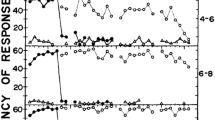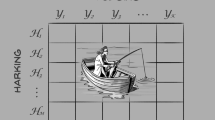Abstract
This paper is aimed at identifying how a model’s explanatory power is constructed and identified, particularly in the practice of template-based modeling (Humphreys, Philos Sci 69:1–11, 2002; Extending ourselves: computational science, empiricism, and scientific method, 2004), and what kinds of explanations models constructed in this way can provide. In particular, this paper offers an account of non-causal structural explanation that forms an alternative to causal–mechanical accounts of model explanation that are currently popular in philosophy of biology and cognitive science. Clearly, defences of non-causal explanation are far from new (e.g. Batterman, Br J Philos Sci 53:21–38, 2002a; The devil in the details: asymptotic reasoning in explanation, reduction, and emergence, 2002b; Pincock, Noûs 41:253–275, 2007; Mathematics and scientific representation 2012; Rice, Noûs. doi:10.1111/nous.12042, 2013; Biol Philos 27:685–703, 2012), so the targets here are focused on a particular type of robust phenomenon and how strong invariance to interventions can block a range of causal explanations. By focusing on a common form of model construction, the paper also ties functional or computational style explanations found in cognitive science and biology more firmly with explanatory practices across model-based science in general.
Similar content being viewed by others
Notes
Phenomena that converge to optimal states are a subset of Woodward’s robustness from ‘fine-tunedness’ (2013, pp. 59–61), since other systems may have a few stable states that they switch between.
Interventions as defined in Woodward (2003).
This comes from an argument against treating optimality models as ‘censored causal models’ of biological evolution (e.g. Elgin and Sober 2002; Potochnik 2007, 2010; for discussion see Rice 2012, 2013). Here, optimality models are seen as ignoring all causal factors related to evolution (genetic, epigenetic, environmental) apart from natural selection, so optimality models isolate a particular part of a casual process. As Rice (2012, 2013; also Matthen and Ariew 2009; Walsh 2007) argues though, there is very little in optimality models that says anything about processes of change or causal dynamics.
References
Baker, A. (2005). Are there genuine mathematical explanations of physical phenomena? Mind, 114, 223–238.
Baker, A. (2009). Mathematical explanation in science. British Journal for the Philosophy of Science, 60, 611–633.
Baron, S. (2013). Optimisation and mathematical explanation: Doing the Lévy Walk. Synthese, 3, 1–21.
Batterman, R. (2002a). Asymptotics and the role of minimal models. The British Journal for the Philosophy of Science, 53, 21–38.
Batterman, R. (2002b). The devil in the details: Asymptotic reasoning in explanation, reduction, and emergence. Oxford: Oxford University Press.
Batterman, R. (2009). Idealization and modeling. Synthese, 169, 427–446.
Batterman, R. (2010). On the explanatory role of mathematics in empirical science. The British Journal for the Philosophy of Science, 61, 1–25.
Bayer, H., & Glimcher, P. W. (2005). Midbrain dopamine neurons encode a quantitative reward prediction error signal. Neuron, 47, 129–141.
Bechtel, W. (2010). The downs and ups of mechanistic research: Circadian rhythm research as an exemplar. Erkenntnis, 73, 313–328.
Bechtel, W. (2011). Mechanism and biological explanation. Philosophy of Science, 78, 533–557.
Bechtel, W. (2012). Understanding endogenously active mechanisms: A scientific and philosophical challenge. European Journal for Philosophy of Science, 2, 233–248.
Bechtel, W., & Abrahamsen, A. (2010). Dynamic mechanistic explanation: Computational modeling of circadian rhythms as an exemplar for cognitive science. Studies in History and Philosophy of Science, 41, 321–333.
Bechtel, W., & Abrahamsen, A. (2011). Complex biological mechanisms: Cyclic, oscillatory, and autonomous. In C. Hooker (Ed.), Philosophy of complex systems (pp. 257–285). Amsterdam: Elsevier.
Bechtel, W., & Abrahamsen, A. (2013). Thinking dynamically about biological mechanisms: Networks of coupled oscillators. Foundations of Science, 8, 707–723.
Bokulich, A. (2008). Can classical structures explain quantum phenomena? British Journal for the Philosophy of Science, 59, 217–235.
Bokulich, A. (2011). How scientific models can explain. Synthese, 180(1), 33–45.
Bokulich, A. (2012). Distinguishing explanatory from nonexplanatory fictions. Philosophy of Science, 79, 725–737.
Botvinick, M. M. (2012). Hierarchical reinforcement learning and decision making. Current Opinion in Neurobiology, 22, 956–962.
Brigandt, I. (2013). Systems biology and the integration of mechanistic explanation and mathematical explanation. Studies in History and Philosophy of Biological and Biomedical Sciences, 44, 477–492.
Bull, J. J., & Wang, I. N. (2010). Optimality models in the age of experimental evolution and genomics. Journal of Evolutionary Biology, 23, 1820–1838.
Calcott, B. (2011). Wimsatt and the robustness family: Review of Wimsatt’s re-engineering philosophy for limited beings. Biology and Philosophy, 26, 281–293.
Chklovskii, D. B., Schikorski, T., & Stevens, C. F. (2002). Wiring optimization viewpoint in cortical circuits. Neuron, 34, 341–347.
Corrado, G., & Doya, K. (2007). Understanding neural coding through the model-based analysis of decision making. The Journal of Neuroscience, 27, 8178–8180.
Corrado, G., Sugrue, L., Brown, J. R., & Newsome, W. (2009). The trouble with choice: Studying decision variables in the brain. In P. Glimcher, C. F. Camerer, R. Fehr, & R. A. Poldrack (Eds.), Neuroeconomics: Decision making and the brain (pp. 463–480). New York: Academic Press.
Craver, C. F. (2006). When mechanistic models explain. Synthese, 153, 355–376.
Craver, C. F. (2007). Explaining the brain. Oxford: Oxford University Press.
Craver, C. F. (2013). Functions and mechanisms: A perspectivalist view. In P. Huneman (Ed.), Functions: Selection and mechanisms (pp. 133–158). Dordrecht: Springer.
Dayan, P., & Niv, Y. (2008). Reinforcement learning: The good, the bad and the ugly. Current Opinion in Neurobiology, 18, 185–196.
Elgin, M., & Sober, E. (2002). Cartwright on explanation and idealization. Erkenntnis, 57, 441–450.
Glimcher, P. W. (2011). Understanding dopamine and reinforcement learning: The dopamine reward prediction error hypothesis. Proceedings of the National Academy of Science of the United States of America, 108(S3), 15647–15654.
Griffiths, T. L., & Tenenbaum, J. B. (2006). Optimal predictions in everyday cognition. Psychological Science, 17, 767–773.
Hampton, A. N., Bossaerts, P., & O’Doherty, J. P. (2006). The role of the ventromedial prefrontal cortex in abstract state-based inference during decision making in humans. Journal of Neuroscience, 26, 8360–8367.
Humphreys, P. (2002). Computational models. Philosophy of Science, 69, 1–11.
Humphreys, P. (2004). Extending ourselves: Computational science, empiricism, and scientific method. Oxford: Oxford University Press.
Huneman, P. (2010). Topological explanations and robustness in biological sciences. Synthese, 177, 213–245.
Irvine, E. Model-based theorizing in cognitive neuroscience. British Journal for the Philosophy of Science (forthcoming).
Ito, M., & Doya, K. (2011). Multiple representations and algorithms for reinforcement learning in the cortico-basal ganglia circuit. Current Opinion in Neurobiology, 21, 368–373.
Jovancevic-Misic, J., & Hayhoe, M. (2009). Adaptive gaze control in natural environments. Journal of Neuroscience, 29, 6234–6238.
Kaplan, D. M. (2011). Explanation and description in computational neuroscience. Synthese, 183, 339–373.
Kaplan, D. M., & Craver, C. F. (2011). The explanatory force of dynamical and mathematical models in neuroscience: A mechanistic perspective. Philosophy of Science, 78, 601–627.
Knuuttila, T. (2011). Modelling and representing: An artefactual approach to model-based representation. Studies in History and Philosophy of Science, 42, 262–271.
Levy, A., & Bechtel, W. (2013). Abstraction and the organisation of mechanisms. Philosophy of Science, 80, 241–261.
Machamer, P. K., Darden, L., & Craver, C. F. (2000). Thinking about mechanisms. Philosophy of Science, 67, 1–25.
Maia, T. V. (2009). Reinforcement learning, conditioning, and the brain: Successes and challenges. Cognitive, Affective, and Behavioral Neuroscience, 9, 343–364.
Mäki, U. (2011). Models and the locus of their truth. Synthese, 180, 47–63.
Mäki, U. (2013). On a paradox of truth, or how not to obscure the issue of whether explanatory models can be true. Journal of Economic Methodology, 20, 268–279.
Marr, D. (1982). Vision. Freeman Press.
Matthen, M., & Ariew, A. (2009). Selection and causation. Philosophy of Science, 76, 201–224.
Montague, P. R., Dayan, P., & Sejnowski, T. J. (1996). A framework for mesencephalic dopamine systems based on predictive Hebbian learning. Journal of Neuroscience, 16, 1936–1947.
Niv, Y., Edlund, J. A., Dayan, P., & O-Doherty, J. P. (2012). Neural prediction errors reveal a risk-sensitive reinforcement-learning process in the human brain. The Journal of Neuroscience, 32, 551–562.
Parker, G. A., & Maynard Smith, J. (1990). Optimality theory in evolutionary biology. Nature, 348, 27–33.
Pérez-Escudero, A., Rivera-Alba, M., & de Polavieja, G. G. (2009). Structure of deviations from optimality in biological systems. Proceedings of the National Academy of Sciences of the United States of America, 106, 20544–20549.
Pincock, C. (2007). A role for mathematics in the physical sciences. Noûs, 41, 253–275.
Pincock, C. (2012). Mathematics and scientific representation. Oxford: Oxford University Press.
Pitt, M. A., & Myung, I. J. (2002). When a good fit can be bad. Trends in Cognitive Science, 6, 421–425.
Potochnik, A. (2007). Optimality modeling and explanatory generality. Philosophy of Science, 74, 680–691.
Potochnik, A. (2010). Explanatory independence and epistemic interdependence: A case study of the optimality approach. British Journal for the Philosophy of Science, 61, 213–233.
Reiss, J. (2012). The explanation paradox. Journal of Economic Methodology, 19, 43–62.
Rice, C. (2012). Optimality explanations: A plea for an alternative approach. Biology and Philosophy, 27, 685–703.
Rice, C. (2013). Moving beyond causes: Optimality models and scientific explanation. Noûs. doi:10.1111/nous.12042.
Roberts, S., & Pashler, H. (2000). How persuasive is a good fit? A comment on theory testing. Psychological Review, 107, 358–367.
Schultz, W., Apicella, P., & Ljungberg, T. (1993). Responses of monkey dopamine neurons to reward and conditioned stimuli during successive steps of learning a delayed response task. Journal of Neuroscience, 13, 900–913.
Schultz, W., Dayan, P., & Montague, P. R. (1997). A neural substrate of prediction and reward. Science, 275, 1593–1599.
Sober, E. (1983). Equilibrium explanation. Philosophical Studies, 43, 201–210.
Strevens, M. (2004). The causal and unification approaches to explanation unified—Causally. Noûs, 38, 154–176.
Strevens, M. (2008). Depth: An account of scientific explanation. Harvard: Harvard University Press.
Walsh, D. (2007). The pomp of superfluous causes: The interpretation of evolutionary theory. Philosophy of Science, 74, 281–303.
Weisberg, M. (2006). Robustness analysis. Philosophy of Science, 73, 730–742.
West, S. A. (2009). Sex allocation. Princeton: Princeton University Press.
Winsberg, E. B. (2010). Science in the age of computer simulation. Chicago: Chicago University Press.
Woodward, J. (2003). Making things happen: A theory of causal explanation. Oxford: Oxford University Press.
Woodward, J. (2006). Some varieties of robustness. Journal of Economic Methodology, 13, 219–240.
Woodward, J. (2013). II—Mechanistic explanation: Its scope and limits. Aristotelian Society Supplementary, 87, 39–65.
Acknowledgments
Many thanks to Markus Eronen and Raphael van Riel for organizing the ‘Explanatory Power 2’ workshop that parts of this paper were prepared for, and the audience there for their comments. Thanks also to Matteo Colombo, Kim Sterelny, and Chris Lean for feedback on earlier versions of the paper, and to Catherine Stinson for discussions on models.
Author information
Authors and Affiliations
Corresponding author
Rights and permissions
About this article
Cite this article
Irvine, E. Models, robustness, and non-causal explanation: a foray into cognitive science and biology. Synthese 192, 3943–3959 (2015). https://doi.org/10.1007/s11229-014-0524-0
Received:
Accepted:
Published:
Issue Date:
DOI: https://doi.org/10.1007/s11229-014-0524-0




